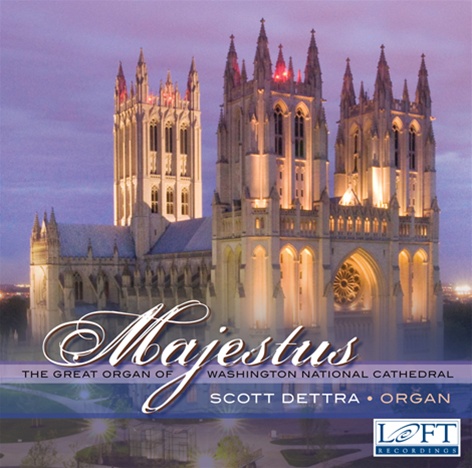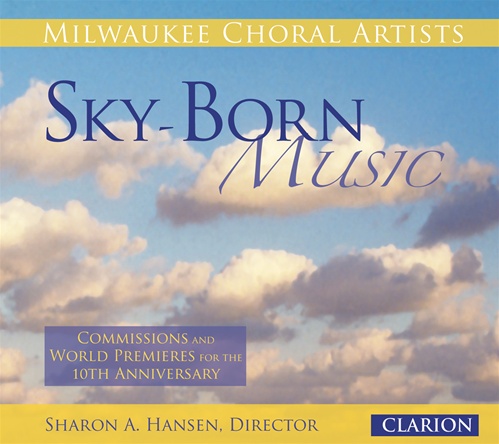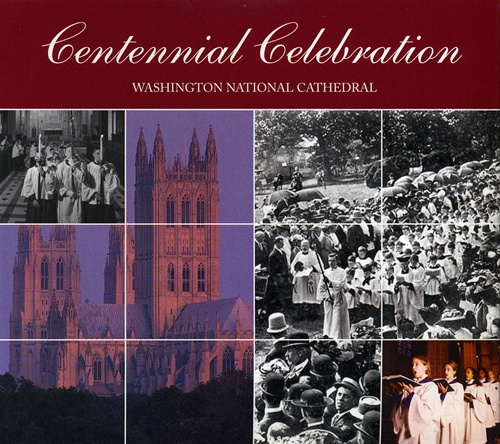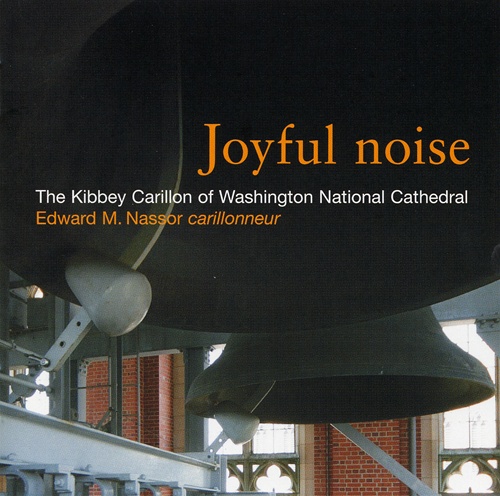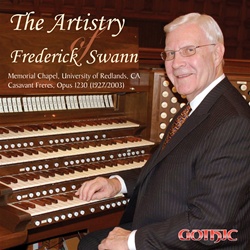Last week we told you about our new release
Eternal Light by the East Carolina University Chamber Singers, so today we wanted to give you some program notes from the album!
Hymn to the Creator of Light John Rutter (b. 1945)
The double-choir anthem Hymn to the Creator of Light was composed in 1993 by Englishman John Rutter, whose style is influenced by the choral music of countrymen Holst, Howells, and Britten. Rutter, equally adept as a conductor, arranger and editor, as well as a composer, founded his famed choir The Cambridge Singers in 1981, with whom he has made many recordings of a wide range of choral repertoire. Hymn to the Creator of Light, Rutter’s musical setting of two poems by Lancelot Andrewes (1555-1626) and J. Franck (1618), opens with a mysterious unison melody in Choir II, reminiscent of Britten’s melodic sensibility. Choir I joins with an accompanying texture of unpredictable and chromatic chords which leads to a dense, full sonority before this pattern repeats and intensifies. The second section, marked Allegro energico, features a more traditional antiphony, as both choirs rapidly exchange lines of poetry in an upbeat, conversational fashion. In the final section, which quotes the German chorale tune Schmücke dich by Johann Crüger (1598-1662), the choirs combine in hymn-like fashion, with Choir I presenting the chorale tune in unison. The serenity and repose of this final section, coupled with the richness of eight-part counterpoint leads to a closing of unspeakable transcendence.
“O Thou Great Power in Whom I Move” Anthony Maglione (b.1978)
Christopher Grymes, clarinet
Anthony J. Maglione, active as a tenor soloist, conductor, and composer, has earned degrees in music from Westminster Choir College (BM) and East Carolina University (MM), and is currently finishing his DMA coursework at UCLA. O Thou Great Power in Whom I Move, written by Maglione for the ECU Chamber Singers in 2008, features the first verse of the poem, A Hymn to my God in a night of my late Sicknesse, by Sir Henry Wotton (1568-1639), an English diplomat and author. Written for four-part choir and solo clarinet, the piece is based on an original hymn-like melody that reoccurs in variation throughout. The clarinet solo explores both high and low registers of the instrument, and stands in stark relief to the choir’s rhythmic simplicity by way of virtuosic runs and elegant ornaments. The climax of the piece, in which the clarinet and choir join in ravishing chains of suspensions, is among the most thrilling moments on this premiere recording, and shows Maglione’s writing at its most lush and lyrical.
Veni Sancte Spiritus Mark G. Sirett (b. 1952)
Award-winning conductor and composer Mark Sirett completed his motet Veni sancte spiritus in 2000. Sirett has graduate degrees in choral conducting and pedagogy from the University of Iowa and serves as the Founding Artistic Director of the Cantabile Choirs in his native Kingston, Ontario. This antiphonal motet inspired by Charles V. Stanford’s Beati quorum via, draws a contrast between men’s and women’s voices as well as the Latin text by Stephen Langton, Archbishop of Canterbury (d. 1228) with an English translation by John Austin (1613-69). Sirett uses the dialogue between the upper and lower voices to create a dramatic intensification leading up to the climactic moment when both choirs, singing in the same language for the first time, ask the Holy Spirit to “fill the heart with Thy light.”
Ave Maria Cary Boyce (b. 1955)
The ancient text Ave Maria was set by Cary Boyce for Carmen Téllez and the Indiana University Contemporary Music Ensemble. Born in California in 1955, Boyce earned his doctorate in composition from Indiana University at Bloomington and is currently the artistic co-director and composer-in-residence for the Aguavá New Music Festival. He has written works in several genres, including scores for documentaries featured on PBS. Written for twelve parts, Boyce’s often dissonant setting reflects the individual thoughts and prayers of a congregation echoing through a cathedral and features excerpts of the original chant melodies. The twelve-part texture exploits the potential for highly diffuse polyphony as well as bold homophonic statements of great power, and the wonderful, reverberant acoustic of St. Paul’s Episcopal Church embraces and enlivens the affect, sending the congregational prayer echoing heavenward.
Cedit, Hyems (Be Gone, Winter!) Abbie Betinis (b. 1980)
Christine Gustafson, flute
Wisconsin native Abbie Betinis has degrees in composition from St. Olaf College and the University of Minnesota, and has spent summers in Paris studying counterpoint in the tradition of Nadia Boulanger. She has a professed passion for elucidating ancient texts, including the two poems from the 4th and 14th centuries that she has intertwined in her imaginative piece, Cedit Hyems (2007), commissioned for the Dale Warland Singers. The first musical statement acts as a prologue to Christ’s birth, illuminating the confusion and darkness of Prudentius’ anticipatory text through a series of dissonant chords which lack real resolution. The fanciful solo flute part explores the full register of the instrument and, when combined with percussive whispers from the choir, creates the bleak winter scene of the second text from the Benedictbeuern manuscript of the Carmina Burana. With unpredictable rhythms and meter changes throughout, the choir eventually sings away the winter, triumphantly announcing at the end of the piece, “Christ has come, winter depart!” This is the premiere recording of this piece.
O quam gloriosum Howard Helvey (b. 1968)
Christopher Grymes, clarinet
O Quam Gloriosum was commissioned by Dr. Mark Simmons and the Cliff Singers of Briar Cliff University, Sioux City, Iowa, in February 2003. Howard Helvey, active as a composer, arranger and pianist, serves as the organist/choirmaster at Calvary Episcopal Church in Cincinnati, Ohio. He wrote the piece with spacious, reverberant European cathedrals in mind, which led him to compose a work of tranquil and impressionistic sonority reminiscent of Olivier Messiaen’s O sacrum convivium. The clarinet part, which was premiered by Dr. Simmons’ wife Amy Simmons, moves in sweeping improvisatory gestures entwined within the choir’s ubiquitous, sustained sonority. The almost hypnotic and shimmering quality of the work’s harmonic language creates an atmosphere of celebratory repose appropriate for the Vespers service for which the text is intended.
De profundis Ildebrando Pizzetti (1880-1968)
Italian composer Ildebrando Pizzetti studied at the Parma Conservatory and spent most of his career focused on opera. Even though he received his formative musical training during the early twentieth century, a time of experimentation in atonal music, Pizzetti was a conservative, embracing the traditions of Renaissance choral music and Italian madrigals. Informed by his studies of these genres, Pizzetti wrote music sensitive to his chosen pastoral or sacred texts. His admittedly obscure (but eminently rewarding!) setting of De profundis (Psalm 130) begins with a four-part men’s chorus featuring falling arpeggios depicting a descent to ‘the depths’ from which the author of the psalm writes. The women’s delicate and unexpected entrance creates a thick, seven-part texture reminiscent of the late Renaissance but enhanced by extended triadic harmony of an impressionistic or post-romantic flavor. This lush middle portion of the motet rises to a powerful climax as each part repeatedly asks the Lord, “Who will withstand?” Suddenly, the lower three parts repeat their supplication that the Lord be attentive, chanting on a tritone, one of the most dissonant of intervals, while the sopranos float above, singing “Domine” (“Lord”). This anxious moment then gives way to the reassuring major mode as the text changes mood: “But with you, there is forgiveness…”
Agnus Dei Egil Hovland (b. 1924)
Christopher Ulffers, bassoon
Organist and composer Egil Hovland was born in Norway in 1924. After studying organ at the Oslo Conservatory, Hovland’s compositional breakthrough came in the 1950s, as he wrote instrumental music as well as music for the Lutheran church. It is his church music that has earned him his stature among Nordic composers, with over 150 works to his credit. In his Agnus Dei Concert for bassoon and mixed choir cappella (Op. 167), Hovland uniquely combines the instrumental and sacred music genres with a four-movement concerto for bassoon and mixed choir. Throughout the piece, the bassoon frequently performs extended virtuosic solo passages that explore all ranges of the instrument in improvisatory, cadenza-like fashion, combining writing that is both delicate and lyrical, with passages of significant technical bravura. The choir, whose presence is primarily organ-like in its homophonic, accompanying role, often serves as a murmuring background with only a few moments of climactic upstaging. Perhaps the most arresting and beautiful moments in the work exploit the choir’s ability to beautifully maintain long sustained passages underneath the solo bassoon – as at the end of the third movement. The chorale-like texture that closes the second movement and the brief final movement, entitled Choral and based on the Olympic Hymn, suggest a kinship with chorale-infused cantatas of J.S. Bach and serve as a reminder of Hovland’s Lutheran roots. In this exquisite and simple final movement, the choir shares the focus for the first time, perhaps in order to emphasize the importance of the text, “dona nobis pacem” (“grant us peace”). The Chamber Singers gave the North American premiere of Agnus Dei at St. Paul’s Episcopal Church on February 26, 2009, and this is the premiere recording.
“I’ve Been in the Storm So Long” arr. Jefferey L. Ames (b. 1969)
Jeffery L. Ames’s original setting of the African-American Spiritual I’ve Been in the Storm So Long was written as a response to the tragedy Hurricane Katrina brought to the Gulf Coast in August 2005. Dr. Ames is the Director of Choral Activities at Belmont University and holds a Ph.D in Choral Conducting/Choral Music Education from Florida State University. The choir’s opening ascending harmonic clusters bring to mind the rising waters of the Gulf of Mexico as the mezzo-soprano soloist sings in anguish, “Give me little time to pray.” With heart-wrenching harmonies, the choir joins her plea, until a four-part women’s chorus sings reassuringly, “Oh when I get to heaven, I’ll walk all about… Dere’ll be nobody there to turn me out.” The piece ends with echoes of the original supplication as the soloist floats above the rest of the singers singing low in their registers, like an angel of mercy coming to the aid of those on earth.
“Nobody knows the trouble I’ve seen” arr. Gail B. Poch (b. 1936)
Gail B. Poch completed his arrangement of the well-known spiritual Nobody Knows the Trouble I’ve Seen for his choir, The University Singers, at Temple University in Philadelphia in 1977. Mr. Poch spent thirty-three years on faculty at Temple and has since retired to Massachusetts with his family. This remarkable and lovely arrangement revels in chromatic, yet beautiful harmonies that are both lush and simple - not unlike the text itself. Poch usually employs an eight-part texture, allowing him to create dramatic contrasting moments when one part starts a phrase only to have the other parts join, as if to share life’s burdens.
“Eternal Light” Leo Sowerby (1895-1968)
Leo Sowerby was an American composer and church musician from Grand Rapids, Michigan, whose composed in nearly all genres, including choral, orchestral, and other instrumental works. The final years of his career were spent at the Washington National Cathedral, where he founded the College of Church Musicians. The choir favorite, Eternal Light, (1958) is a rich and beautiful setting of moving words by Alcuin (735-804), an English educator, theologian, and leading scholar at the court of Charlemagne. Sowerby highlights the text through a syllabic, speech-like setting with melodies that rise and fall with the natural shape of each phrase, and harmonies that are subtly jazz-inspired.


